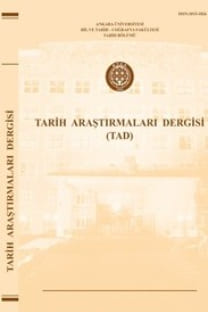15. YÜZYIL PORTEKİZ KEŞİFLERİNİN AFRİKA’DA TEZÂHÜRÜ VE BİR HAKİMİYET GÖSTERGESİ OLARAK PADRÃO SEMBOLÜ
Keşifler çağı, Portekiz, Afrika, padrão, kâşif
APPEARANCE OF THE 15TH CENTURY PORTUGUESE DISCOVERIES IN AFRICA AND THE SYMBOL OF THE PADRÃO AS A METHOD OF DOMINATION
Age of exploration, Portuguese, Africa, padrão, explorer,
___
- Kaynakça Alves, A., Dom Henrique O Infante: Memoria Historica, Typographia do Commercio do Porto, Porto 1894.
- Andrade Moniz, A., “Ceuta e as Duas Polítıcas da Expansão Portuguesa”, Ceuta e Expansão Portuguesa, Actas XIV Simpóio de História Marítima 10 a 12 de Novembro 2015, Academia de Marinha, Lisboa, 2016, s. 239- 247.
- Axelson, E., “Prince Henry the Navigator and the Discovery of the sea route to India”, The Geographical Journal, Blackwell Publishing on behalf of The Royal Geographical Society with the Institue of British Geographers, Vol.127, No:2, London, 1961, s.145-155.
- Azurara, G. E., Chronica do Descobrimento e Conquista de Guiné, J. P. Aillaud: na Officina Typographica de Fain e Thunot, Pariz 1841.
- Barros, J.; Couto, D., Da Asia de João Barros e De Diogo do Couto, Decada I, Parte I, Regia Officina Typografica, Lisboa, 1777-1778.
- Boxer, C. R., The Portuguese Seaborne Empire 1415-1825, The History of Human Society, London 1969.
- Campbell, T., “Portolan Charts from the Late Thirteenth Century to 1500”, The History of Cartography, Volume 1: Cartography in Prehistoric, Ancient and Medieval Europe and the Mediterranean, University of Chicago Press,1987, s. 371-463.
- Castro, F.V., “Navios”, Domingues História da Marinha Portuguesa: Navios, Marinheiros e Arte de Navegar 1500-1600, coordenador: Francisco Contente Domingues, Academia de Marinha, Lisboa 2012.
- Cordeiro, L., Descobertas e Descobridores: Diogo Cão, Imprensa Nacional, Lisboa 1892.
- Crone, G.R., Crone, The Voyages of Cadamosto and Other Documents on Western Afrika in the Second Half of the Fifteenth Century, The Hakluyt Society, London 1937.
- Cruz Coelho, M. H., “Ceuta: Um Marco no Processo Legitimador da Dinastia de Avis”, Ceuta e Expansão Portuguesa, Actas XIV Simpóio de História Marítima 10 a 12 de Novembro 2015, Academia de Marinha, Lisboa 2016, s. 21-32.
- Dear, I. (editör); Kemp, P. (editor), The Oxford Companion to Ship and the Sea (2 ed.), Oxford University Press, 2007.
- Ferreira Brandão, J.A.,Vida do Infante D. Henrique de Portugal Apelidado o Navegador e Seus Resultados, Imprensa Nacional, Lisboa 1876.
- Horta, J.S., “A imagem do Africano pelos Portugueses antes dos contactos” O Confronto do Olhar: O encontro dos povos na época da Navegações portuguesas Séculos XV e XVI, Colecção Universitária, Lisboa 1991, s.43-70.
- Parry, J.H., The Age of Reconnaissance: Discovery, Exploration and Settlement 1450 to 1650, University of California Press, California 1981.
- Pedrosa, F.G., “Os navios”, coordenador: Fernando Gomes Pedrosa, História da Marinha Portuguesa: Navios, Marinheiros e Arte de Navegar 1139-1499, Academia de Marinha, Lisboa 1997.
- Pickering, W., The Conquerors Of The New World And Their Bondsmen: Being a Narrative of the Principal Events Which Led to Negro Slavery in the West Indies and America, Volume I, London 1848.
- Pombo, M.R., “Diogo Cão”, Angola, Serie 1 Número 4, Amadeu Amorim, Luanda 1932.
- Ravenstein, E.G., “The Voyages of Diogo Cão and Bartolomeu Dias 1482-88”, The Geographical Journal, Vol.16, No.6, The Royal Geographical Society, London 1900, s. 625-655.
- Schwarz, G.R., The History and Development of Caravels, Texas A&M University, 2008.
- Soares, A.X., Portuguese Vocables in Asiatic Languages: From the Portuguese Original of Sebastião Rodolfo Dalgado: Translated into English with notes, additions and comments, Asian Educational Services, New Delhi 1988.
- Souza, T. O. M., “O Infante D. Henrique e a Escola Naval de Sagres”, Revista de História, C. 21(44), São Paulo 1960, s. 451-464.
- Velho, A., A Journal of the First Voyage of Vasco Da Gama 1497-1499, Hakluyt Society, London 1898.
- Vigário, E., “What happened to Diogo Cão?”, 2013.
- Woodward, D., Medieval Mappaemundi, The History of Cartography, Volume I: Cartography in Prehistoric, Ancient and Medieval Europe and the Mediterranean, University of Chicago Press,1987, s.286-370.
- Zurara, G. E., Crónica da Tomada de Ceuta por el Rei D. João I, por Francisco Maria Esteves Pereira, Academia das Sciêncãs de Lisboa, Lisboa 1915.
- ISSN: 1015-1826
- Yayın Aralığı: 2
- Başlangıç: 1963
- Yayıncı: Levent KAYAPINAR
PAKİSTAN’IN ADI VE KURULUŞUNDA CHOUDHARY RAHMET ALİ VE BİLDİRİSİNİN ÖNEMİ
HARF İNKILABI VE MİLLET MEKTEPLERİ: EDİRNE ÖRNEĞİ (1928-1935)
Dördüncü Krallık ve Helenizm Retoriği
Çevirmen: Murat KEÇİŞ, Çevirmen: Mehmet YAĞCI
İSTANBUL'DA HUSUSİ 'ANA MEKTEBİ' (EKİM 1909)
HOCEND MÜDAFAASI VE BİR DİRENİŞ ÖRNEĞİ: TİMUR MELİK
ANADOLU'DA İSLAM VE HRİSTİYANLIK DÖNEMLERİNDE HAYIR KURUMLARI VE YAPILARIN KORUNMASI
ANADOLU'DA İSLAM VE HRİSTİYANLIK DÖNEMLERİNDE HAYIR KURUMLARI VE YAPILARIN KORUNMASI
